用户:Fferic/Testpage3

The United States has 58 protected areas known as national parks, which are operated by the National Park Service, an agency of the Department of the Interior. National parks must be established by an act of the United States Congress. The first national park, Yellowstone, was signed into law by President Ulysses S. Grant in 1872, followed by Sequoia and Yosemite in 1890. The Organic Act of 1916 created the National Park Service "to conserve the scenery and the natural and historic objects and wildlife therein, and to provide for the enjoyment of the same in such manner and by such means as will leave them unimpaired for the enjoyment of future generations."[1] National parks usually have a variety of natural resources over large areas.[2] Many of them had been previously protected as National Monuments by the President under the Antiquities Act before being upgraded by Congress. Seven national parks are paired with a National Preserve, six of which are in Alaska. While administered together, they are considered as separate units and their areas are not included in the figures below. The newest national park is Great Sand Dunes, established in 2004.
Twenty-seven states have national parks, as do insular areas American Samoa and the United States Virgin Islands. Alaska and California have the most, each with eight, followed by Utah with five and Colorado with four. The largest national park is Wrangell – St. Elias, at over 8,000,000英亩(32,000平方千米), followed by three more in Alaska; the smallest is Hot Springs, at less than 6,000英亩(24平方千米). The total area protected by national parks is approximately 51,900,000英亩(210,000平方千米), for an average of 895,000英亩(3,620平方千米) but a median of only 317,000英亩(1,280平方千米).[2] The most-visited national park is Great Smoky Mountains, with over nine million visitors in 2008, followed by the Grand Canyon, with over four million.[3] Fourteen national parks are designated World Heritage Sites.[4]
A few national parks are no longer designated as such, having been redesignated or disbanded. Other designations of National Park Service areas are sometimes also called national parks; they are listed here.
国家公园
[编辑]| 名称 | 图片 | 位置 | 成立时间[2][5] | 面积[2] | 叙述 |
|---|---|---|---|---|---|
| 阿科底亚 | 
|
缅因州 44°21′N 68°13′W / 44.35°N 68.21°W |
1919年2月26日 | 47,389.67英亩(191.8平方千米) | 包括大部分山沙岛(Mount Desert Island)及其他岛屿,阿科底亚保留大西洋沿岸最高的山、花岗岩山峰、海岸线、林地与湖泊。这里有淡水、河口、森林和潮间带栖息地。[6] |
| 美属萨摩亚国家公园 | 
|
美属萨摩亚 14°15′S 170°41′W / 14.25°S 170.68°W |
1988年10月31日 | 9,000.00英亩(36.4平方千米) | 美国最南端的国家公园,涵盖三座萨摩亚岛屿,保护珊瑚礁,热带雨林,火山山脉和白沙滩。此地也是萨摩亚人、萨摩亚狐蝠、棕鲣鸟、海龟及900种鱼类的故乡。[7] |
| 拱门 | 
|
犹他州 38°41′N 109°34′W / 38.68°N 109.57°W |
1971年11月12日 | 76,518.98英亩(309.7平方千米) | 这里拥有包括精致拱门在内,超过2,000座自然砂岩拱。这些天然拱是受到沙漠气候长达百万年的侵蚀所形成,干旱土地形成维持生命的土壤结皮与坑洞、天然水份收集洼地。其他地质景观有石柱、石锥、石鳍、和石塔。[8] |
| 恶地 | 
|
南达科他州 43°45′N 102°30′W / 43.75°N 102.50°W |
1978年11月10日 | 242,755.94英亩(982.4平方千米) | 恶地拥有许多孤山、尖岩、石锥和草原。这里是渐新世起最大的化石层,并有美洲野牛、大角羊、黑足鼬和草原狐等野生动物。[9] |
| 大弯 | 
|
德州 29°15′N 103°15′W / 29.25°N 103.25°W |
1935年6月20日 | 801,163.21英亩(3,242.2平方千米) | 以美墨边界的格兰德河在此地的大弯曲而命名,范围还包括了一部份奇瓦瓦沙漠。境内有各式各样的白垩纪与第三纪化石,与美洲原住民的文化艺品。[10] |
| 比斯坎 | 
|
佛罗里达州 25°39′N 80°05′W / 25.65°N 80.08°W |
1980年6月28日 | 172,924.07英亩(699.8平方千米) | 位于比斯坎湾、佛罗里达礁岛群最北端,有著四个相互关联的海洋生态系统:红树林、海湾、礁岛和珊瑚礁。濒危动物有西印度海牛、美洲鳄、各种海龟与游隼。[11] |
| 甘尼森黑峡谷 | 
|
科罗拉多州 38°34′N 107°43′W / 38.57°N 107.72°W |
1999年10月21日 | 32,950.03英亩(133.3平方千米) | 本公园涵盖四分之一的甘尼森河,并有形成于前寒武纪的黑峡谷。黑峡谷有著十分陡峭的斜坡,也是泛舟和攀岩的地点。此狭窄陡峭的峡谷由片麻岩和片岩所组成,常因阴影而呈现黑色。[12] |
| 布莱斯峡谷 | 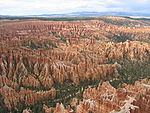
|
犹他州 37°34′N 112°11′W / 37.57°N 112.18°W |
1928年2月25日 | 35,835.08英亩(145.0平方千米) | 布莱斯峡谷是庞沙冈特高原(Paunsaugunt Plateau)旁的巨大自然露天剧场。这个独特的地区有著数以百计因侵蚀而形成的高耸岩柱(Hoodoo)。本地最初为美洲原住民居住地,之后摩门教拓荒者定居于此。[13] |
| 峡谷地 | 
|
犹他州 38°12′N 109°56′W / 38.2°N 109.93°W |
1964年92月12日 | 337,597.83英亩(1,366.2平方千米) | 科罗拉多河、绿河及其支流在此形成峡谷、孤山、方山的侵蚀地形,并将公园分为四区。这里有尖峰及其它自然雕刻岩石,以及古普韦布洛人(Ancient Pueblo Peoples)的文物。[14] |
| 国会礁岩 | 
|
犹他州 38°12′N 111°10′W / 38.20°N 111.17°W |
1971年12月18日 | 241,904.26英亩(979.0平方千米) | 公园内的水袋折曲(Waterpocket Fold)是个100英里(160千米)长的单斜褶皱(monocline),显现出地球的地质层。其他自然景观有独石柱、砂岩圆顶和貌似美国国会大厦的悬崖。[15] |
| 卡尔斯贝洞窟 | 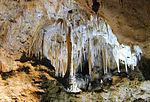
|
新墨西哥州 32°10′N 104°26′W / 32.17°N 104.44°W |
1930年5月14日 | 46,766.45英亩(189.3平方千米) | 卡尔斯贝洞窟共有117座洞窟,其中最长的洞窟超过120英里(190千米)。Big Room长达4,000英尺(1,200米),这些洞窟也是400,000只墨西哥游离尾蝠及16个其他物种的栖息地。地表则是奇瓦瓦沙漠(Chihuahuan Desert)与响尾蛇温泉(Rattlesnake Springs)。[16] |
| 海峡群岛 | 
|
加州 34°01′N 119°25′W / 34.01°N 119.42°W |
1980年3月5日 | 249,561.00英亩(1,009.9平方千米) | 此公园涵盖了海峡群岛8座岛屿中的5座,有一半面积是在水下。这些岛屿有独特的地中海生态系统,是2,000多种陆上动植物的栖息地,其中有145个特有种。本地原为丘马什人(Chumash people)的居住地。[17] |
| 康加里 | 
|
南卡罗莱那州 33°47′N 80°47′W / 33.78°N 80.78°W |
2003年11月10日 | 26,545.86英亩(107.4平方千米) | 本公园是北美最大的古老冲积平原森林。部分树木是美国东部最高的树木,木板环道(Boardwalk Loop)是穿越沼泽的高架步道。[18] |
| 火山口湖 | 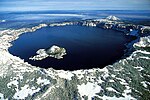
|
奥勒冈州 42°56′N 122°06′W / 42.94°N 122.1°W |
1902年5月22日 | 183,224.05英亩(741.5平方千米) | 火山口湖位于马札马火山的火山口,在7,700年前因火山爆发而形成。这是美国最深的湖泊,以碧蓝的湖色及清澈度而闻名。湖中有两座没有出入口的小岛,所有湖水来自于降水。[19] |
| 库雅荷加谷 | 
|
俄亥俄州 41°14′N 81°33′W / 41.24°N 81.55°W |
2000年10月11日 | 32,860.73英亩(133.0平方千米) | 沿著库雅荷加河(Cuyahoga River),有瀑布、山丘、小径,并展现早期农村生活并有沿著俄亥俄与伊利运河(Ohio and Erie Canal)兴建的脚踏车道。[20] |
| 死亡谷 | 
|
加州、内华达州 36°14′N 116°49′W / 36.24°N 116.82°W |
1994年10月31日 | 3,372,401.96英亩(13,647.6平方千米) | 死亡谷是全美最炎热、地势最低且最干燥的地区。这里有峡谷、颜色缤纷的荒地、沙丘、山脉、位于断层带上的地堑还有超过1000种植物。其它景观有盐地、温泉和孤山。[21] |
| 迪纳利 | 
|
阿拉斯加州 63°20′N 150°30′W / 63.33°N 150.50°W |
1917年2月26日 | 4,740,911.72英亩(19,185.8平方千米) | 迪纳利国家公园以北美最高峰麦金利山为中心,是通往惊奇湖(Wonder Lake)的唯一道路。麦金利山与其他属于阿拉斯加山脉的山峰被长久的冰川和寒带森林所覆盖。野生生物有灰熊、白大角羊、驯鹿和灰狼。[22] |
| 干龟 | 
|
佛罗里达州 24°38′N 82°52′W / 24.63°N 82.87°W |
1992年10月26日 | 64,701.22英亩(261.8平方千米) | 干龟群岛(Dry Tortugas)位于佛罗里达礁岛群最西端,西半球最大的砖石建筑杰佛逊堡(Fort Jefferson)位于此地。公园大部分为水域,拥有许多珊瑚礁与沉船,只能透过飞机与船只进入。[23] |
| 大沼泽地 | 
|
佛罗里达州 25°19′N 80°56′W / 25.32°N 80.93°W |
1934年5月30日 | 1,508,537.90英亩(6,104.8平方千米) | 佛罗里达大沼泽地是美国最大的亚热带荒原。这里的红树林生态系统及出海口是36个保育物种的栖息地,包括有佛罗里达山豹、美洲鳄和西印度海牛。部分地区已被抽乾和发展。修复工程的目的在于保存此地的生态。[24] |
| 北极门 | 
|
阿拉斯加州 67°47′N 153°18′W / 67.78°N 153.30°W |
1980年12月2日 | 7,523,897.74英亩(30,448.1平方千米) | 这座最北端的国家公园涵盖部分布鲁克斯山脉,并且没有任何公园设施。本地是阿拉斯加原住民的故乡,他们11,000年以来靠著这块土地与驯鹿生活。[25] |
| 冰川 | 
|
蒙大拿州 48°48′N 114°00′W / 48.80°N 114.00°W |
1910年5月11日 | 1,013,572.41英亩(4,101.8平方千米) | 为沃特顿-冰川国际和平公园一部份,在高耸的洛矶山脉中有26座冰川与130座已命名湖泊。在冰川快速后退的此区有历史悠久的旅馆及具有里程碑意义的道路。因逆冲断层形成的山脉有著全世界最佳的元古宙沉积化石。[26] |
| 冰川湾 | 
|
阿拉斯加州 58°30′N 137°00′W / 58.50°N 137.00°W |
1980年12月2日 | 3,224,840.31英亩(13,050.5平方千米) | 冰川湾有许多潮汐冰河、山脉和峡湾。此处的温带雨林和海湾是灰熊,山羊,鲸鱼,海豹和鹰的栖息地。在乔治·温哥华于1794年发现此地时,整座海湾都是被冰川所覆盖,但冰川现已后退了65英里(105千米)。[27] |
| 大峡谷 | 
|
亚利桑那州 36°04′N 112°08′W / 36.06°N 112.14°W |
1919年2月26日 | 1,217,403.32英亩(4,926.7平方千米) | 被科罗拉多河所切割的科罗拉多大峡谷277英里(446千米)长,深1英里(1.6千米),宽15英里(24千米)。百万年的暴露形成了多层颜色的科罗拉多高原。[28] |
| 大蒂顿 | 
|
怀俄明州 43°44′N 110°48′W / 43.73°N 110.80°W |
1929年2月26日 | 309,994.66英亩(1,254.5平方千米) | 大蒂顿是蒂顿山脉最高峰。公园内的杰克逊洞(Jackson Hole)山谷和山麓湖泊,与自冰川覆盖的山谷陡然升起的高山形成对比。[29] |
| 大盆地 | 
|
内华达州 38°59′N 114°18′W / 38.98°N 114.30°W |
1986年10月27日 | 77,180.00英亩(312.3平方千米) | 围绕惠勒峰 (Wheeler Peak)的大盆地有5000年的芒松(Bristlecone pine)、冰川冰碛和石灰岩李曼洞穴(Lehman Caves)。这里有全美最暗的夜空,并有汤氏大耳蝠(Townsend's big-eared bat)、叉角羚和邦纳维尔割喉鳟(Bonneville cutthroat trout)等物种。[30] |
| 大沙丘 | 
|
科罗拉多州 37°44′N 105°31′W / 37.73°N 105.51°W |
2004年9月14日 | 42,983.74英亩(173.9平方千米) | 此处有北美最高的沙丘,达750英尺(230米),因格兰德河在圣路易斯山谷(San Luis Valley)的沙土沉积所形成,并有草原、灌木林和湿地。公园内还有高山湖泊、六座13,000英尺(4,000米)高的山峰及古老树林。[31] |
| 大烟山 | 
|
北卡罗莱那州、田纳西州 35°41′N 83°32′W / 35.68°N 83.53°W |
1926年5月22日 | 521,490.13英亩(2,110.4平方千米) | 属于阿帕拉契山脉的大烟山有个广大的高地,成为400种脊椎动物、100种树种与5000种植物的栖息地。登山是公园内的主要活动,包括70英里(110千米)的阿帕拉契小径在内共有长达800英里(1,300千米)的山径。其他活动有钓鱼,骑马,以及参观近80个历史建筑。[32] |
| 瓜达洛普山 | 
|
德州 31°55′N 104°52′W / 31.92°N 104.87°W |
1966年10月15日 | 86,415.97英亩(349.7平方千米) | 公园内有德州最高峰瓜达洛普山(Guadalupe Peak)、被北美大齿槭(Bigtooth Maple)覆盖的麦基垂克峡谷(McKittrick Canyon)、部分奇瓦瓦沙漠和二叠纪生物礁化石。[33] |
| 海勒卡拉 | 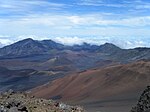
|
夏威夷州 20°43′N 156°10′W / 20.72°N 156.17°W |
1916年8月1日 | 29,093.67英亩(117.7平方千米) | 位于茂宜岛上的海勒卡拉火山有著遍布火山渣锥的巨大火山口、有著外来树种的霍斯摩小路(Hosmer's Grove)、有著当地的夏威夷雁。基帕胡卢(Kipahulu)地区有许多淡水鱼生活的湖泊。这个国家公园有多的濒危物种。[34] |
| 夏威夷火山 | 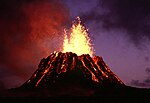
|
夏威夷州 19°23′N 155°12′W / 19.38°N 155.20°W |
1916年8月1日 | 323,431.38英亩(1,308.9平方千米) | 本国家公园位于夏威夷岛,范围包括两座全世界最为活跃的基拉韦厄峰与冒纳罗亚火山。公园内有著从海平面到13,000英尺(4,000米)高的多样生态系统。[35] |
| 温泉 | 
|
阿肯色州 34°31′N 93°03′W / 34.51°N 93.05°W |
1921年3月4日 | 5,549.75英亩(22.5平方千米) | 唯一位于都会区的国家公园。这座面积最小的国家公园是基于作为公共使用的温泉而成立。浴室排(Bathhouse Row)保留了47座含有许多对人体有益矿物质的温泉。[36] |
| 罗亚尔岛 | 
|
密西根州 48°06′N 88°33′W / 48.10°N 88.55°W |
1931年月3日 | 571,790.11英亩(2,314.0平方千米) | 罗亚尔岛为苏必略湖最大岛,本公园也是唯二座无法由道路进入的国家公园之一。这座游客稀少的国家公园是个被隔离的地点与荒野。这里有许多沉船、水路和远足小径。本公园也包含了超过400座小岛以及距离岛屿4.5英里(7.2千米)的水域。这里只有20种哺乳动物,以特殊的狼与驼鹿关系而闻名。[37] |
| 约书亚树 | 
|
加州 33°47′N 115°54′W / 33.79°N 115.90°W |
1994年10月31日 | 789,745.47英亩(3,196.0平方千米) | 涵盖范围包括部分科罗拉多沙漠与莫哈维沙漠、小圣贝纳迪诺山脉,是约书亚树栖息地。公园内有沙丘、干涸湖泊,崎岖山脉和花岗岩巨石。[38] |
| 卡特迈 | 
|
阿拉斯加州 58°30′N 155°00′W / 58.50°N 155.00°W |
1980年12月2日 | 3,674,529.68英亩(14,870.3平方千米) | 卡特迈位于阿拉斯加半岛,保留1912年诺瓦拉普塔山(Novarupta)爆发而形成的万烟谷(Valley of Ten Thousand Smokes),以及卡特迈山(Mount Katmai)。超过2,000只棕熊来到此地捕捉产卵的鲑鱼。[39] |
| 基奈峡湾 | 
|
阿拉斯加州 59°55′N 149°39′W / 59.92°N 149.65°W |
1980年12月2日 | 669,982.99英亩(2,711.3平方千米) | 基奈峡湾国家公园靠近基奈半岛(Kenai Peninsula)上的苏厄德(Seward),范围包括哈丁冰原(Harding Icefield)与38座香关的冰川和峡湾。一般民众唯一能由道路进入的地区是出口冰河(Exit Glacier),但目前只能透过乘船观赏冰川景色。[40] |
| 国王峡谷 | 
|
加州 36°48′N 118°33′W / 36.80°N 118.55°W |
1890年10月1日 | 461,901.20英亩(1,869.2平方千米) | 为多种巨杉林和世界第二大的格兰特将军树的栖地,本公园还包含部分国王河、花岗岩国王峡谷和圣华金河以及伯伊登洞穴(Boyden Cave)。[41] |
| 科伯克谷 | 
|
阿拉斯加州 67°33′N 159°17′W / 67.55°N 159.28°W |
1980年12月2日 | 1,750,716.50英亩(7,084.9平方千米) | 科伯克河(Kobuk River)在科伯克谷绵延61英里(98千米),本公园还包含了三座沙丘。因冰河而产生的大小科伯克和杭特河沙丘可达100英尺(30米)高与100 °F(38 °C),他们也是北极圈最大的沙丘。每半年,有五十万驯鹿因迁徙而跨越沙丘和有著冰河时代化石的悬崖。这里是游客数最少的国家公园。[42] |
| 克拉克湖 | 
|
阿拉斯加州 60°58′N 153°25′W / 60.97°N 153.42°W |
1980年12月2日 | 2,619,733.21英亩(10,601.7平方千米) | 本公园以克拉克湖为中心,有著4座活跃火山,境内包括堡垒火山(Mount Redoubt);河川、冰河和瀑布,并有温带雨林,冻土高原与三座山脉。[43] |
| 拉森火山 | 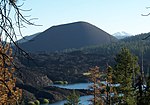
|
加州 40°29′N 121°31′W / 40.49°N 121.51°W |
1916年8月9日 | 106,372.36英亩(430.5平方千米) | 世界上最大的穹顶火山拉森火山与其他三种火山共同组成此国家公园:盾状火山、火山渣锥和层状火山。除了上次爆发在1915年的火山以外,本公园还有许多水热区,包括火山喷气孔、沸池和蒸气地面。[44] |
| 猛犸洞 | 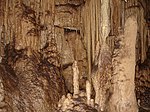
|
肯塔基州 37°11′N 86°06′W / 37.18°N 86.10°W |
1926年5月25日 | 52,830.19英亩(213.8平方千米) | 猛犸洞绘制的通道长达365英里(587千米),是目前为止全球最长的洞穴系统。动物包括5种蝙蝠、肯塔基洞穴虾(Kentucky cave shrimp)、洞穴鱼和蝾螈。地面则有河流、登山山径、灰岩坑,和温泉。[45] |
| 梅萨维德 | 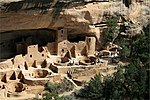
|
C科罗拉多州 37°11′N 108°29′W / 37.18°N 108.49°W |
1906年6月29日 | 52,121.93英亩(210.9平方千米) | 本区有超过4,000座古普韦布洛人遗址。有著走道与隧道的崖屋兴建于12至13世纪,其中著名的有150间房间和23间地穴(kiva)的崖宫(Cliff Palace)和阳台屋(Balcony House)。[46] |
| 瑞尼尔山 | 
|
华盛顿州 46°51′N 121°45′W / 46.85°N 121.75°W |
1899年3月2日 | 235,625.00英亩(953.5平方千米) | 活火山瑞尼尔山是喀斯喀特山脉中最著名的山峰。瑞尼尔山被26座已命名冰河所覆盖,包括卡本冰河(Carbon Glacier)和美国本土最大的艾孟斯冰河(Emmons Glacier)。瑞尼尔山以登山活动著名,本公园有超过一半是被亚高山带和高山带森林所覆盖。位于南坡的乐园是全世界降雪最多的地方之一,朗迈尔(Longmire)游客中心是环山的仙境山径(Wonderland Trail)起点。[47] |
| 北喀斯喀特 | 
|
华盛顿州 48°42′N 121°12′W / 48.70°N 121.20°W |
1968年10月2日 | 504,780.94英亩(2,042.8平方千米) | 包含罗斯湖国家保护区(Ross Lake National Recreation Area)和奇兰湖国家保护区(Lake Chelan National Recreation Area)。这里有许多冰河、知名登山和攀岩区喀斯喀特关口(Cascade Pass)、舒克桑山(Mount Shuksan)、凯旋山(Mount Triumph)和埃尔多拉多峰(Eldorado Peak)。[48] |
| 奥林匹克国家公园 | 
|
华盛顿州 47°58′N 123°30′W / 47.97°N 123.50°W |
1938年6月29日 | 922,650.86英亩(3,733.8平方千米) | 位于奥林匹克半岛,公园范围从太平洋海岸的潮池到温带雨林到奥林匹斯山。。冰川覆盖的奥林匹克山脉眺望霍河雨林(Hoh Rain Forest)与奎诺尔特雨林(Quinault Rain Forest)-美国本土的最西方。[49] |
| Petrified Forest | 
|
Arizona 35°04′N 109°47′W / 35.07°N 109.78°W |
1962年12月9日 | 93,532.57英亩(378.5平方千米) | This portion of the Chinle Formation has a great concentration of 225-million-year-old petrified wood. The surrounding region, the Painted Desert, has eroded red-hued volcanic rock called bentonite. There are also dinosaur fossils and over 350 Native American sites.[50] |
| Redwood | 
|
California 41°18′N 124°00′W / 41.30°N 124.00°W |
1968年10月2日 | 112,512.05英亩(455.3平方千米) | This park and the co-managed state parks protect almost half of all remaining Coastal Redwoods, the tallest trees on Earth. There are three large river systems in this very seismically active area, and the 37英里(60千米) of protected coastline have tide pools and seastacks. The prairie, estuary, coast, river, and forest ecosystems have varied animal and plant species.[51] |
| Rocky Mountain | 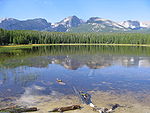
|
Colorado 40°24′N 105°35′W / 40.40°N 105.58°W |
1915年1月26日 | 265,828.41英亩(1,075.8平方千米) | This section of the Rocky Mountains has ecosystems varying in elevation from the over 150 riparian lakes to Montane and subalpine forests to the alpine tundra. Large wildlife including mule deer, bighorn sheep, black bears, and cougars inhabit these igneous mountains and glacier valleys. The fourteener Longs Peak and Bear Lake are popular destinations.[52] |
| Saguaro | 
|
Arizona 32°15′N 110°30′W / 32.25°N 110.50°W |
1994年10月14日 | 91,439.71英亩(370.0平方千米) | Split into the separate Rincon Mountain and Tucson Mountain Districts, the dry Sonoran Desert is still home to much life in six biotic communities. Beyond the namesake Giant Saguaro cacti, there are barrel cacti, cholla cacti, and prickly pears, as well as Lesser Long-nosed Bats, Spotted Owls, and javelinas.[53] |
| Sequoia | 
|
California 36°26′N 118°41′W / 36.43°N 118.68°W |
1890年9月25日 | 404,051.17英亩(1,635.1平方千米) | This park protects the Giant Forest, which has the world's largest tree, General Sherman, as well as four of the next nine. It also has over 240 caves, the tallest mountain in the lower 48, Mount Whitney, and the granite dome Moro Rock.[54] |
| Shenandoah | 
|
Virginia 38°32′N 78°21′W / 38.53°N 78.35°W |
1926年5月22日 | 199,045.23英亩(805.5平方千米) | Shenandoah's Blue Ridge Mountains are covered by hardwood forests that are home to tens of thousands of animals. The Skyline Drive and Appalachian Trail run the entire length of this narrow park that has more than 500英里(800千米) of hiking trails along scenic overlooks and waterfalls of the Shenandoah River.[55] |
| Theodore Roosevelt | 
|
North Dakota 46°58′N 103°27′W / 46.97°N 103.45°W |
1978年11月10日 | 70,446.89英亩(285.1平方千米) | This region that enticed and influenced President Theodore Roosevelt is now a park of three units in the badlands. Besides Roosevelt's historic cabin, there are scenic drives and backcountry hiking opportunities. Wildlife includes American Bison, pronghorns, Bighorn sheep, and wild horses.[56] |
| Virgin Islands | 
|
United States Virgin Islands 18°20′N 64°44′W / 18.33°N 64.73°W |
1956年8月2日 | 14,688.87英亩(59.4平方千米) | The island of Saint John has rich human and natural history. There are Taino archaeological sites and ruins of sugar plantations from Columbus's time. Past the pristine beaches are mangroves, seagrass beds, coral reefs and algal plains.[57] |
| Voyageurs | 
|
Minnesota 48°30′N 92°53′W / 48.50°N 92.88°W |
1971年1月8日 | 218,200.17英亩(883.0平方千米) | This park on four main lakes, a site for canoeing, kayaking, and fishing, has a history of Ojibwe Native Americans, French fur traders called voyageurs, and a gold rush. Formed by glaciers, this region has tall bluffs, rock gardens, islands and bays, and historic buildings.[58] |
| Wind Cave | 
|
South Dakota 43°34′N 103°29′W / 43.57°N 103.48°W |
1903年1月9日 | 28,295.03英亩(114.5平方千米) | Wind Cave is distinctive for its calcite fin formations called boxwork and needle-like growths called frostwork. The cave, which was discovered by the sound of wind coming from a hole in the ground, is the world's densest cave system. Above ground is a mixed-grass prairie with animals such as bison, black-footed ferrets, and prairie dogs.[59] |
| Wrangell – St. Elias | 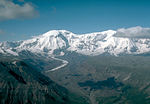
|
Alaska 61°00′N 142°00′W / 61.00°N 142.00°W |
1980年12月2日 | 8,323,147.59英亩(33,682.6平方千米) | This mountainous land has the convergence of the Alaska, Chugach, and Wrangell-Saint Elias Ranges, which have many of the continent's tallest mountains over 16,000英尺(4,900米), including Mount Saint Elias. More than 25% of this park of volcanic peaks is covered with glaciers, including the tidewater Hubbard Glacier, piedmont Malaspina Glacier, and valley Nabesna Glacier.[60] |
| Yellowstone | 
|
Wyoming, Montana, Idaho 44°36′N 110°30′W / 44.60°N 110.50°W |
1872年3月1日 | 2,219,790.71英亩(8,983.2平方千米) | Situated on the Yellowstone Caldera, the first national park in the world has vast geothermal areas such as hot springs and geysers, the best-known being Old Faithful and Grand Prismatic Spring. The yellow-hued Grand Canyon of the Yellowstone River has numerous waterfalls, and four mountain ranges run through the park. There are almost 60 mammal species, including the gray wolf, grizzly bear, lynx, bison, and elk.[61] |
| Yosemite | 
|
California 37°50′N 119°30′W / 37.83°N 119.50°W |
1890年10月1日 | 761,266.19英亩(3,080.7平方千米) | Yosemite has towering cliffs, waterfalls, and sequoias in a diverse area of geology and hydrology. Half Dome and El Capitan rise from the central glacier-formed Yosemite Valley, as does Yosemite Falls, North America's tallest waterfall. Three Giant Sequoia groves and vast wilderness are home to diverse wildlife.[62] |
| Zion | 
|
Utah 37°18′N 113°03′W / 37.30°N 113.05°W |
1919年11月19日 | 146,597.60英亩(593.3平方千米) | This geologically unique area has colorful sandstone canyons, high plateaus, and rock towers. Natural arches and exposed formations of the Colorado Plateau make up a large wilderness of four ecosystems.[63] |
See also
[编辑]- List of areas in the United States National Park System
- History of the National Park Service
- List of National Historic Landmarks of the United States
- List of National Monuments of the United States
- List of tourist attractions worldwide
- List of U.S. National Forests
References
[编辑]- ^ The National Park Service Organic Act. National Park Service. 26 February 2008 [25 January 2010].
- ^ 2.0 2.1 2.2 2.3 The National Parks: Index 2005–2007 (PDF). Washington, D.C.: National Park Service. [19 March 2010]. ISBN 9780912627755.
- ^ 10 Most Visited National Parks (2008) (PDF). National Park Service. [25 January 2010].
- ^ World Heritage List. UNESCO World Heritage Centre. [6 February 2010].
- ^ National Park System Areas Listed in Chronological Order of Date Authorized under DOI (PDF). National Park Service. 27 June 2005 [18 January 2010].
- ^ Acadia National Park. National Park Service. [23 March 2010].
- ^ National Park of American Samoa. National Park Service. [23 March 2010].
- ^ Arches National Park. National Park Service. [23 March 2010].
- ^ Badlands National Park. National Park Service. [23 March 2010].
- ^ Big Bend National Park. National Park Service. December 08, 2009.
- ^ Biscayne National Park. National Park Service. [23 March 2010].
- ^ Black Canyon of the Gunnison National Park. National Park Service. [23 March 2010].
- ^ Bryce Canyon National Park. National Park Service. [23 March 2010].
- ^ Canyonlands National Park. National Park Service. [23 March 2010].
- ^ Capitol Reef National Park. National Park Service. [23 March 2010].
- ^ Carlsbad Caverns National Park. National Park Service. [23 March 2010].
- ^ Channel Islands National Park. National Park Service. [23 March 2010].
- ^ Congaree National Park. National Park Service. [23 March 2010].
- ^ Crater Lake National Park. National Park Service. [23 March 2010].
- ^ Cuyahoga Valley National Park. National Park Service. [23 March 2010].
- ^ Death Valley National Park. National Park Service. [23 March 2010].
- ^ Denali National Park. National Park Service. [23 March 2010].
- ^ Dry Tortugas National Park. National Park Service. [23 March 2010].
- ^ Everglades National Park. National Park Service. [23 March 2010].
- ^ Gates of the Arctic National Park. National Park Service. [23 March 2010].
- ^ Glacier National Park. National Park Service. [23 March 2010].
- ^ Glacier Bay National Park. National Park Service. [23 March 2010].
- ^ Grand Canyon National Park. National Park Service. [23 March 2010].
- ^ Grand Teton National Park. National Park Service. [23 March 2010].
- ^ Great Basin National Park. National Park Service. [23 March 2010].
- ^ Great Sand Dunes National Park. National Park Service. [23 March 2010].
- ^ Great Smoky Mountains National Park. National Park Service. [23 March 2010].
- ^ Guadalupe Mountains National Park. National Park Service. [23 March 2010].
- ^ Haleakala National Park. National Park Service. [23 March 2010].
- ^ Hawaii Volcanoes National Park. National Park Service. [23 March 2010].
- ^ Hot Springs National Park. National Park Service. [23 March 2010].
- ^ Isle Royale National Park. National Park Service. [23 March 2010].
- ^ Joshua Tree National Park. National Park Service. [23 March 2010].
- ^ Katmai National Park. National Park Service. [23 March 2010].
- ^ Kenai Fjords National Park. National Park Service. [23 March 2010].
- ^ Kings Canyon National Park. National Park Service. [23 March 2010].
- ^ Kobuk Valley National Park. National Park Service. [23 March 2010].
- ^ Lake Clark National Park. National Park Service. [23 March 2010].
- ^ Lassen Volcanic National Park. National Park Service. [23 March 2010].
- ^ Mammoth Cave National Park. National Park Service. [23 March 2010].
- ^ Mesa Verde National Park. National Park Service. [23 March 2010].
- ^ Mount Rainier National Park. National Park Service. [23 March 2010].
- ^ North Cascades National Park. National Park Service. [23 March 2010].
- ^ Olympic National Park. National Park Service. [23 March 2010].
- ^ Petrified Forest National Park. National Park Service. [23 March 2010].
- ^ Redwood National Park. National Park Service. [23 March 2010].
- ^ Rocky Mountain National Park. National Park Service. [23 March 2010].
- ^ Saguaro National Park. National Park Service. [23 March 2010].
- ^ Sequoia National Park. National Park Service. [23 March 2010].
- ^ Shenandoah National Park. National Park Service. [23 March 2010].
- ^ Theodore Roosevelt National Park. National Park Service. [23 March 2010].
- ^ Virgin Islands National Park. National Park Service. [23 March 2010].
- ^ Voyageurs National Park. National Park Service. [23 March 2010].
- ^ Wind Cave National Park. National Park Service. [23 March 2010].
- ^ Wrangell – St. Elias National Park. National Park Service. [23 March 2010].
- ^ Yellowstone National Park. National Park Service. [23 March 2010].
- ^ Yosemite National Park. National Park Service. [23 March 2010].
- ^ Zion National Park. National Park Service. [23 March 2010].
External links
[编辑]- 官方网站 of the National Park Service
- Find a Park by the NPS
- The National Parks: America's Best Idea by PBS

